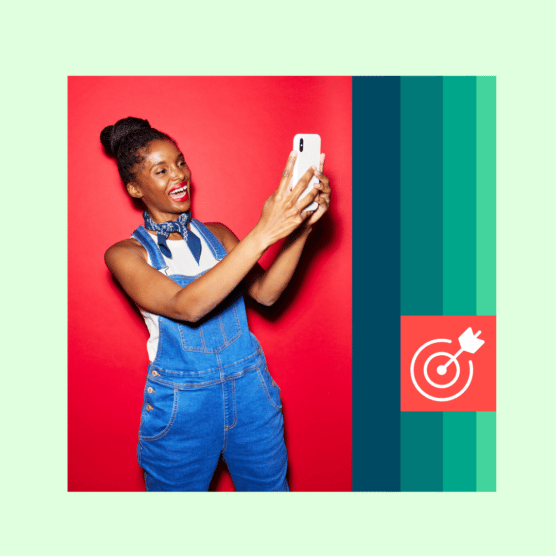The language of digital advertising can be confusing: ROI, UTMs, CTRs… One particularly common question is: what exactly is the difference between a boosted post vs ad on social platforms?
It’s a bit of a tricky one to answer because boosted posts are technically a form of social advertising. However, they are created, promoted, and reported on differently from other social ads.
Boosted posts are the very easiest way for social advertisers to get started. That means it’s important to understand how they work – and how they can work for you. But you also need to understand their limitations compared to other social ads. Read on to clear up the boosted post vs ad distinction once and for all.
Bonus: Download a free guide to social advertising and learn the 5 steps to building effective campaigns. No tricks or boring tips—just simple, easy-to-follow instructions that really work.
Boosted posts vs. ads: what’s the difference?
The main difference that identifies a boosted post vs ad is that boosted posts generally (but not always) start as organic content. Other social ads are created from scratch using business tools like Meta Ads Manager or LinkedIn Campaign Manager.
Boosted posts are created with just a few clicks, whereas other social ads require a few more advanced steps to get your campaign underway. The flip side is that regular social ads offer more formats and ad objectives than boosted posts do.
Most businesses can benefit from both boosted posts and social ads. That said, newer social advertisers and smaller social teams will probably focus more on boosted posts. Larger and more experienced teams will have the capacity to lean into more complex social ads and campaigns.
What’s a boosted post?
A boosted post is simply a social post to which you add some advertising dollars in an effort to expand its reach or increase engagement. All you have to do is choose a few simple targeting options and add a budget.
A boosted post looks almost exactly the same as regular organic content. Except, it will have a “sponsored” or”promoted” label in the viewer’s social media feed. It may also have a clickable call to action (for website clicks or messaging) that does not appear in the original organic post.
Boosted posts can include text, images, and video.
For example, here’s an organic Reel from Understance’s Instagram page:
And here’s how that same Reel appeared as a boosted post in my Instagram feed:
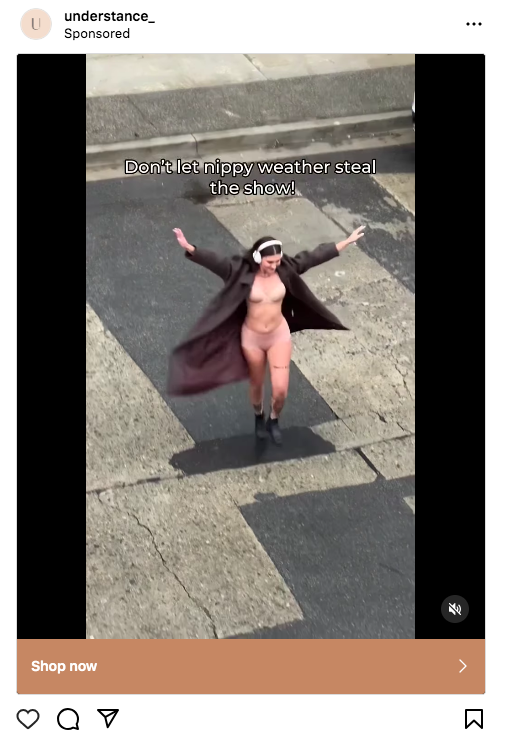
Source: @understance_
Note the Sponsored label at the top and Shop Now CTA link. Otherwise, the two posts are identical.
There are two options when creating a boosted post:
- Add budget to an existing post that is performing well.
- Create a new post specifically to boost it (rather than sharing it first as an organic post). This allows you to take advantage of the ease of creating a boost post vs ad on Instagram, Facebook, or LinkedIn while also building specifically promotional content that might not be effective as an organic post.
Find out how to boost a post on Facebook, Instagram, and LinkedIn.
What’s a social ad?
A social ad is any content you pay to distribute to a specific audience on social media.
Like we said above, boosted posts are technically a form of social ad. But they are the very most basic form of social advertising. They are created and measured quite differently from other forms of social ads, so they are considered as a separate category.
For all the other forms of social ads, you start from scratch in your selected social platform’s ad management tool. The process is essentially the opposite of creating a boosted post. Instead of starting with content and applying a budget and goal, you start with a goal and budget and then add your content.
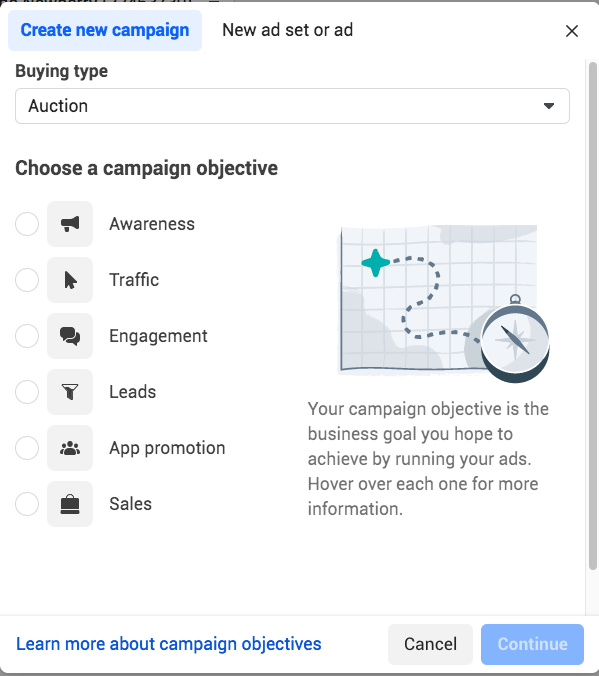
Source: Meta Ads Manager
Pros and cons of boosted posts
Each of these socal advertising strategies has its own advantages and disadvantages. Here’s what you need to know about the good and bad of using a Facebook, Instagram, or LinkedIn boost post vs ad.
Pros
When you notice an organic post is performing particularly well, you can convert it into a boosted post with just a few clicks or taps.
Boosted posts are the easiest and most user-friendly way to start advertising on social platforms. You don’t need any extra design, copywriting, or strategy skills beyond what you used to create the organic content for a boosted post, vs ad tools that work best with additional expertise.
Cons
Boosted posts offer limited advertising objectives. On Meta, the ad objectives for boosted posts are:
- post engagement
- thruplays (for video posts)
- profile visits
- link clicks, or
- messaging conversations started.
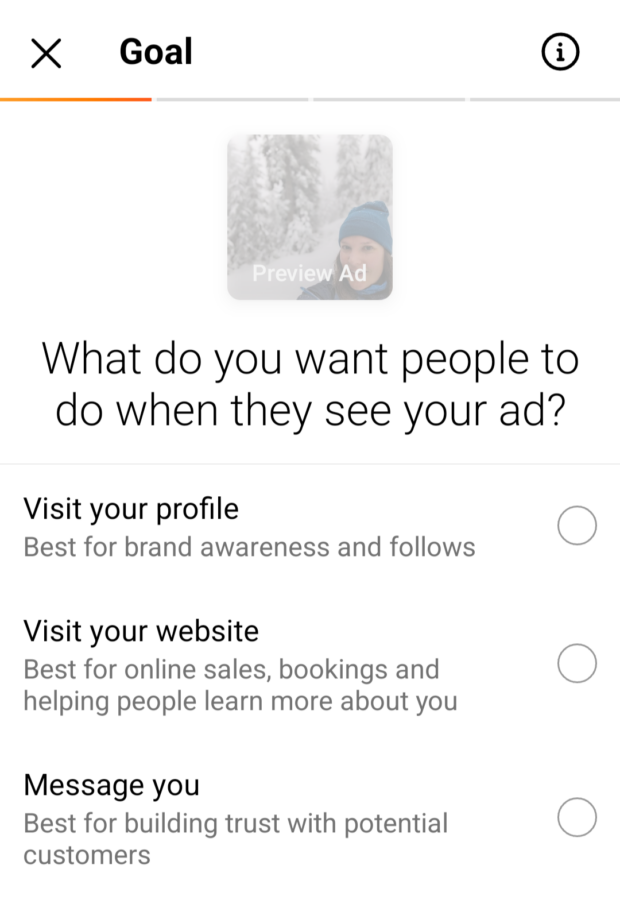
Source: Instagram
On LinkedIn, there are a few more objectives options for boosted posts:
- website visits
- brand awareness
- engagement
- video views, and
- messaging.
But the conversion-oriented objectives like leads and sales are still unavailable for a LinkedIn boosted post, vs ad campaigns created in Campaign Manager.
Another con is that you have limited ad placement choices. With Meta boosted posts specifically, you can only choose placements in Instagram, Facebook mobile feed, and Facebook desktop feed.
And there’s one more con that iPhone users should be aware of. As of February 2024, iPhone users have to pay a 30% service fee on boosted ads created within the Instagram and Facebook iOS apps.
You can avoid these fees by boosting posts from Instagram.com or Facebook.com, by adding prepaid funds to your ad account, or by boosting posts using a tool like Hootsuite. But this change makes it significantly less convenient to boost posts directly within the social apps, at least for iPhone users.
Now we’ll flip the lens and look at the best and the worst of using Instagram, LinkedIn, or Facebook ads vs boosted posts.
Pros
The main pro of social ads is that they offer more customization options than boosted posts.
In particular, there are more business objectives to choose from, including lead generation and sales. For LinkedIn, the job applicants objective is also exclusive to ads created in Campaign Manager.
For those wanting to measure the direct return on investment (ROI) of social ads, these conversion objectives are critical in the long term.
Social ads also offer more ad placement options. On Meta, social ad placements that are not available for boosted posts include Facebook Feed side ads, Messenger ads, Instagram Stories, and the Meta Audience Network.
The targeting options are also more detailed, including lookalike audiences.
Since you create social ads from scratch using the social platform’s ad manager, you have full creative control over the design, copy, and call to action buttons.
Cons
For small social teams (or entrepreneurs who manage their own social channels), that last pro might actually be a con.
Creating social ads from scratch takes more time than simply boosting a post. And to make the most of your social ads budget, it’s a good idea to test various versions of your ads to find out which options convert the best. This might all be more than you have the time or patience to manage.
When should you use boosted posts?
Boosted posts are the best solution when you’re looking to hit the easy button on your social ad campaigns. If you have limited time, a small team, or are just getting started with social advertising, boosted posts may be the best place to start.
Meta doesn’t generally release specifics about the use of Facebook ads vs boosted posts. But way back in 2016, then-COO Sheryl Sandberg told investors: “over 80% of new advertisers in Q2 started with simplified products, like boosted posts.”
Over time you will get a sense of the performance levels of a boost post vs ad on Instagram, Facebook, and LinkedIn. As you learn which types of content perform best as a Meta or LinkedIn boosted post vs ad for your specific business, you will likely want to expand into more complex social ads.
That said, it’s absolutely possible to build an entire social advertising strategy around boosted posts, as long as your advertising goals align with the objectives available. LinkedIn specifically recommends boosting posts that feature thought leadership, customer spotlights, product launches, and events.
Social ads are the only option if you want to create ads that don’t fit within the limits of boosted posts. So, for conversion goals and expanded audience and placement targeting, you’ll want to choose social ads. For example, look at the extensive campaign reporting available for a LinkedIn social ads campaign:
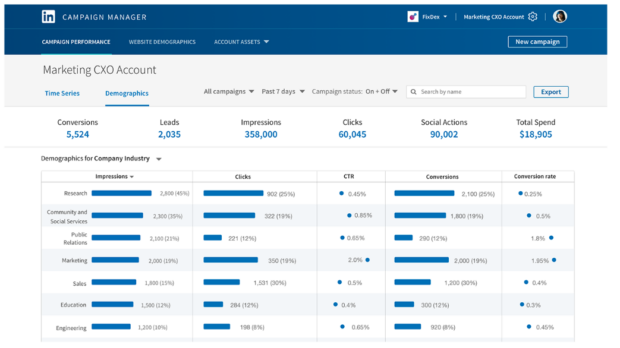
Source: LinkedIn
Social ads are also the best option for A/B testing and campaigns that include multiple ads sets. For these reasons, you may wish to consider social ads even for goals that do fall within the limits of boosted posting.
Overall, brands with a larger ad budget will likely benefit from using full social ads campaigns. While the majority of small Facebook advertisers might start with boosted posts, the majority of ad dollars on Meta platforms come from social ad campaigns. Then-CFO David Wehner told Meta investors in Q3 2022 that boosted ads represented “a relatively small percentage of revenue,” indicating that the much larger percentage comes from social ad campaigns.
Boosting posts and managing ads with Hootsuite
Boosted post vs. ad campaign setup on Hootsuite
Boosting a post on Hootsuite is at least as easy as boosting it from the social platforms themselves, with the added benefit that you can boost posts for multiple platforms all from one screen.
You can also schedule boosted posts in advance, and even set triggers to boost posts automatically based on organic performance or specific keywords.
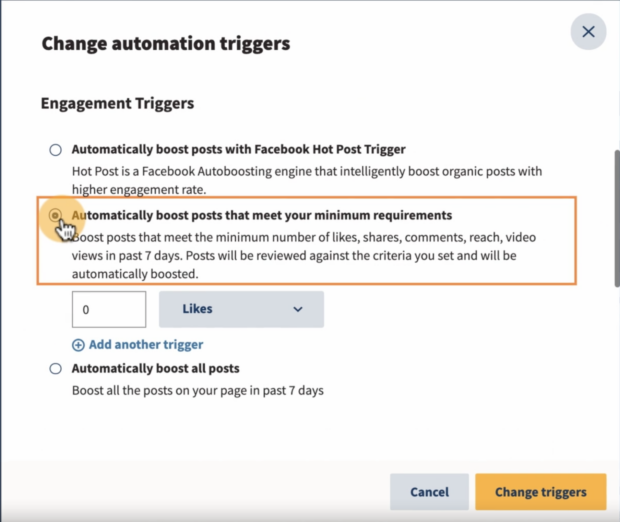
Your boosted posts appear in the same dashboard as your organic content, giving you a birds-eye view of your complete social calendar.
All you have to do is connect your relevant social ad accounts to Hootsuite, then choose the posts you want to boost (or set the targets to boost automatically). Set your budget, target your audience, and your boosted post is good to go.
Tip: If you’re not sure where to start, try allocating a set weekly budget to boosted posts, then setting the automated triggers to promote your top content. This is a relatively hands-off way to expand your audience and start learning what results you can expect to see from your social ad spend.

P.S. Remember how we mentioned above that there’s a 30% fee tacked on for posts boosted directly within iOS Meta apps? This fee does not apply when boosting posts through Hootsuite.
Social ads on Hootsuite
Just like when you create your social ads within the various platforms’ native ads management tools, Hootsuite gives you more customization and targeting features when creating social ads than for a simple boosted post.
But unlike the social platforms’ native advertising tools, you can use Hootsuite Social Advertising to plan, create, manage, schedule, and report on all your paid and organic content for Facebook, Instagram, and LinkedIn without switching tabs.
That means you can adjust your cross-platform social ads strategy on the fly, and even reallocate budget from one platform to another from just one screen.
Perhaps even more important, you can plan your social ads to complement your organic content, rather than compete with those organic views. And when you’re ready to check your results, you’ll get in-depth reporting that helps you learn and refine your strategy to increase your performance and ROI over time.

Hootsuite Advanced Analytics even reports on ROI specifically, so you can see exactly how much return you got for every dollar you spent on each social platform.
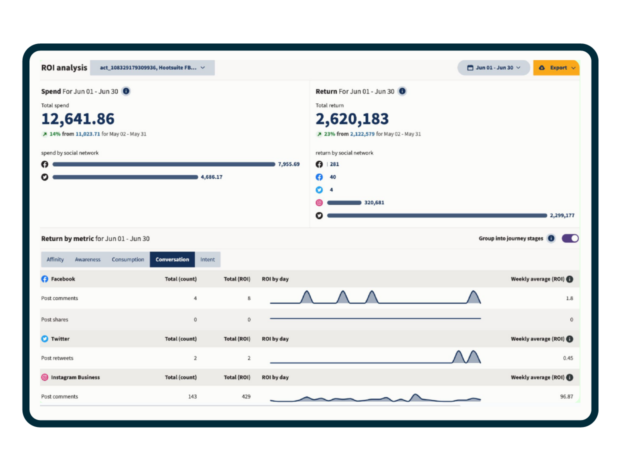
Integrate your paid and organic social strategies to strengthen connections with existing customers and reach new ones. Use Hootsuite Social Advertising to easily keep track of all of your social media activity — including ad campaigns — and get a complete view of your social ROI. Try it for free.
Easily plan, manage and analyze organic and paid campaigns from one place with Hootsuite Social Advertising. See it in action.
Free Demo
